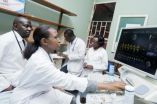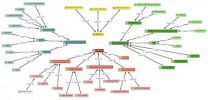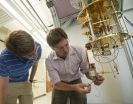(Press-News.org) Medical education in sub-Saharan Africa is being revitalized and expanded through a U.S.-funded effort that is dramatically increasing enrollment, broadening curricula, upgrading Internet access and providing cutting-edge skills labs and other technologies.
In the first substantial publication by participants of the $130 million Medical Education Partnership Initiative (MEPI), more than 225 authors detailed progress being made at the African institutions. Their reports are in a supplement being published today by the journal Academic Medicine. Begun in 2010, MEPI is funded by the President's Emergency Plan for AIDS Relief (PEPFAR) and the National Institutes of Health, and is co-administered by NIH's Fogarty International Center and the Health Resources and Services Administration.
"MEPI is a major venture in international educational innovation that has generated new thinking, energy and optimism in the field of medical education in Africa," the program partners write in a foreword article to the supplement.
The 32 articles include case studies of national strategies to increase numbers of doctors and health professionals trained; educational innovations such as e-learning and regional training sites; research capacity development, and partnerships that leverage advances across the MEPI network.
MEPI participants provided details of accomplishments made through the program, including:
In Zimbabwe, medical student and postgraduate enrollment have both nearly doubled, from 260 in 2010 to 513 in 2013, and the Ministry of Higher Education has committed additional financial support to sustain the progress.
A decentralized training network of 14 regional hospitals has been established in Kenya, and has provided instruction for more than 300 medical, nursing, dental and pharmacy students.
Internal medicine (IM) physicians were in short supply in Mozambique, so salary supplements, Internet access, and notebook computers were offered to encourage recruitment, resulting in an increase in IM residents from 10 before MEPI to 75 in 2012.
Fourteen new master's level programs were begun in Zambia, including physiological sciences, pharmacology, anatomy, pathology, microbiology and nursing.
A virtual microscopy system was introduced in Zambia, containing 4,000 electronic images, which increased student access and is more cost-effective than optical microscopy using glass slides.
A research administration office was created in Ethiopia to assist faculty in grant writing and management, and 18 faculty members were supported to present their research at international conferences.
The supplement on MEPI progress also includes commentaries from global health experts such as former U.S. Global AIDS Coordinator Dr. Eric Goosby, MEPI Coordinating Center principal investigator Dr. Francis G. Omaswa and Fogarty International Center Director Dr. Roger I. Glass.
The critical shortage of physicians, researchers and health care workers across sub-Saharan Africa spurred MEPI's creation. While the region suffers 25 percent of the global burden of disease, it has only 3 percent of the world's health care workers, according to the World Health Organization. The impact of HIV/AIDS created an urgent need to increase capacity, wrote Goosby and his co-author Deborah von Zinkernagel, former PEPFAR deputy. "Although concerns arose that resources were being diverted from "services," it was evident to PEPFAR leadership that the ongoing and expanding needs of the HIV-infected community could not be successfully sustained without increasing the number of trained health professionals," they added.
By awarding the grants directly to African institutions, MEPI is cultivating sustainable local leadership, Omaswa maintained. "For Africa to accelerate the speed of the ongoing transformation, it is necessary for Africans to step up and take ownership and responsibility for what happens in their own backyards," he said.
Research is embedded in curricula developed through MEPI, to expand local capacity that will drive innovation. African scientists have already contributed to many "game-changing" HIV-related advances such as development of rapid diagnostics for detecting and monitoring HIV infections, noted Glass and his Fogarty co-authors. "The research perspective provided to students and faculty, the ability to raise and answer questions and the idea that medical knowledge and practice are continually changing are being supported by MEPI sites and will hopefully endure long after the program ends," they continued.
Initially conceived as a five-year program, MEPI funders and participants are now developing plans for a second phase of investment in Africa's medical education.
INFORMATION:
Fogarty, the international component of the NIH, addresses global health challenges through innovative and collaborative research and training programs and supports and advances the NIH mission through international partnerships. For more information, visit: http://www.fic.nih.gov.
About the National Institutes of Health (NIH): NIH, the nation's medical research agency, includes 27 Institutes and Centers and is a component of the U.S. Department of Health and Human Services. NIH is the primary federal agency conducting and supporting basic, clinical, and translational medical research, and is investigating the causes, treatments, and cures for both common and rare diseases. For more information about NIH and its programs, visit http://www.nih.gov.
Downloadable images of MEPI activities are available here:
http://www.fic.nih.gov/Programs/MedicalEducation/Pages/mepi-photo-gallery.aspx
Publication will be available here:
http://journals.lww.com/academicmedicine/pages/default.aspx
Journal supplement details progress in African medical education
PEPFAR, NIH jointly fund program to strengthen region's healthcare workforce
2014-07-31
ELSE PRESS RELEASES FROM THIS DATE:
Resistance to key malaria drug spreading at alarming rate in Southeast Asia
2014-07-31
WHAT:
Resistance to artemisinin, the main drug to treat malaria, is now widespread throughout Southeast Asia, among the Plasmodium falciparum (P. falciparum) parasites that cause the disease and is likely caused by a genetic mutation in the parasites. However, a six-day course of artemisinin-based combination therapy—as opposed to a standard three-day course—has proved highly effective in treating drug-resistant malaria cases, according to findings published today in the New England Journal of Medicine. The research was conducted by an international team of scientists ...
Biologists describe mechanism promoting multiple DNA mutations
2014-07-30
DNA mutations—long known to fuel cancer as well as evolutionary changes in a living organism—had been thought to be rare events that occur randomly throughout the genome.
However, recent studies have shown that cancer development frequently involves the formation of multiple mutations that arise simultaneously and in close proximity to each other. These groups of clustered mutations are frequently found in regions where chromosomal rearrangements take place.
The discovery, published in the journal Cell Reports, may one day lead to new cancer therapies, according to ...
Classic Lewis Carroll character inspires new ecological model
2014-07-30
Inspired by the Red Queen in Lewis Carroll's Through the Looking Glass, collaborators from the University of Illinois and National University of Singapore improved a 35-year-old ecology model to better understand how species evolve over decades to millions of years.
The new model, called a mean field model for competition, incorporates the "Red Queen Effect," an evolutionary hypothesis introduced by Lee Van Valen in the 1970s, which suggests that organisms must constantly increase their fitness (or ability to survive and reproduce) in order to compete with other ever-evolving ...
Diverticulitis patients reveal psychological, physical symptoms long after acute attacks
2014-07-30
UCLA researchers interviewed people with diverticulitis and confirmed that many suffer psychological and physical symptoms long after their acute illness has passed.
For the study, published this week in the peer-reviewed journal Quality of Life Research, a UCLA team led by Dr. Brennan Spiegel interviewed patients in great detail about the symptoms they experience weeks, months or even years after an acute diverticulitis attack. Their striking findings add to growing evidence that, for some patients, diverticulitis goes beyond isolated attacks and can lead to a chronic ...
Finding quantum lines of desire
2014-07-30
Groundskeepers and landscapers hate them, but there is no fighting them. Called desire paths, social trails or goat tracks, they are the unofficial shortcuts people create between two locations when the purpose-built path doesn't take them where they want to go.
There's a similar concept in classical physics called the "path of least action." If you throw a softball to a friend, the ball traces a parabola through space. It doesn't follow a serpentine path or loop the loop because those paths have higher "actions" than the true path.
But what paths do quantum particles, ...
Tidal forces gave moon its shape, according to new analysis
2014-07-30
The shape of the moon deviates from a simple sphere in ways that scientists have struggled to explain. A new study by researchers at UC Santa Cruz shows that most of the moon's overall shape can be explained by taking into account tidal effects acting early in the moon's history.
The results, published July 30 in Nature, provide insights into the moon's early history, its orbital evolution, and its current orientation in the sky, according to lead author Ian Garrick-Bethell, assistant professor of Earth and planetary sciences at UC Santa Cruz.
As the moon cooled and ...
Target growth-driving cells within tumors, not fastest-proliferating cells
2014-07-30
BOSTON –– Of the many sub-groups of cells jockeying for supremacy within a cancerous tumor, the most dangerous may not be those that can proliferate the fastest, researchers at Dana-Farber Cancer Institute report in a paper appearing in an advance online publication of the journal Nature. The findings have important implications for the treatment of cancer with precision medicines, the study authors explained: Doctors need to ascertain which cell subgroups are truly driving the tumor's growth and metastasis and select drugs that target the critical genes within those cells. ...
ALMA finds double star with weird and wild planet-forming discs
2014-07-30
BOWLING GREEN, O.—From movies to television, obesity is still considered "fair game" for jokes and ridicule. A new study from researchers at Bowling Green State University took a closer look at weight-related humor to see if anti-fat attitudes played into a person's appreciation or distaste for fat humor in the media.
"Weight-Related Humor in the Media: Appreciation, Distaste and Anti-Fat Attitudes," by psychology Ph.D. candidate Jacob Burmeister and Dr. Robert Carels, professor of psychology, is featured in the June issue of Psychology of Popular Media Culture.
Carels ...
Innovative scientists update old-school pipetting with new-age technology
2014-07-30
CAMBRIDGE, Mass. (July 30, 2014) A team of Whitehead Institute researchers is bringing new levels of efficiency and accuracy to one of the most essential albeit tedious tasks of bench science: pipetting. And, in an effort to aid the scientific community at large, the group has established an open source system that enables anyone to benefit from this development free of charge.
Dubbed "iPipet," the system converts an iPad or any tablet computer into a "smart bench" that guides the execution of complex pipetting protocols. iPipet users can also share their pipetting designs ...
Mapping the optimal route between 2 quantum states
2014-07-30
As a quantum state collapses from a quantum superposition to a classical state or a different superposition, it will follow a path known as a quantum trajectory. For each start and end state there is an optimal or "most likely" path, but it is not as easy to predict the path or track it experimentally as a straight-line between two points would be in our everyday, classical world.
In a new paper featured this week on the cover of Nature, scientists from the University of Rochester, University of California at Berkeley and Washington University in St. Louis have shown ...
LAST 30 PRESS RELEASES:
Quantum ‘alchemy’ made feasible with excitons
‘Revoice’ device gives stroke patients their voice back
USF-led study: AI helps reveal global surge in floating algae
New method predicts asthma attacks up to five years in advance
Researchers publish first ever structural engineering manual for bamboo
National poll: Less than half of parents say swearing is never OK for kids
Decades of suffering: Long-term mental health outcomes of Kurdish chemical gas attacks
Interactional dynamics of self-assessment and advice in peer reflection on microteaching
When aging affects the young: Revealing the weight of caregiving on teenagers
Can Canada’s health systems handle increased demand during FIFA World Cup?
Autistic and non-autistic faces may “speak a different language” when expressing emotion
No clear evidence that cannabis-based medicines relieve chronic nerve pain
Pioneering second-order nonlinear vibrational nanoscopy for interfacial molecular systems beyond the diffraction limit
Bottleneck in hydrogen distribution jeopardises billions in clean energy
Lung cancer death rates among women in Europe are finally levelling off
Scientists trace microplastics in fertilizer from fields to the beach
The Lancet Obstetrics, Gynecology, & Women’s Health: Taking paracetamol during pregnancy does not increase risk of autism, ADHD or intellectual disabilities, confirms new gold-standard evidence review
Taking paracetamol during pregnancy does not increase risk of autism, ADHD or intellectual disabilities
Harm reduction vending machines in New York State expand access to overdose treatment and drug test strips, UB studies confirm
University of Phoenix releases white paper on Credit for Prior Learning as a catalyst for internal mobility and retention
Canada losing track of salmon health as climate and industrial threats mount
Molecular sieve-confined Pt-FeOx catalysts achieve highly efficient reversible hydrogen cycle of methylcyclohexane-toluene
Investment in farm productivity tools key to reducing greenhouse gas
New review highlights electrochemical pathways to recover uranium from wastewater and seawater
Hidden pollutants in shale gas development raise environmental concerns, new review finds
Discarded cigarette butts transformed into high performance energy storage materials
Researchers highlight role of alternative RNA splicing in schizophrenia
NTU Singapore scientists find new way to disarm antibiotic-resistant bacteria and restore healing in chronic wounds
Research suggests nationwide racial bias in media reporting on gun violence
Revealing the cell’s nanocourier at work
[Press-News.org] Journal supplement details progress in African medical educationPEPFAR, NIH jointly fund program to strengthen region's healthcare workforce







